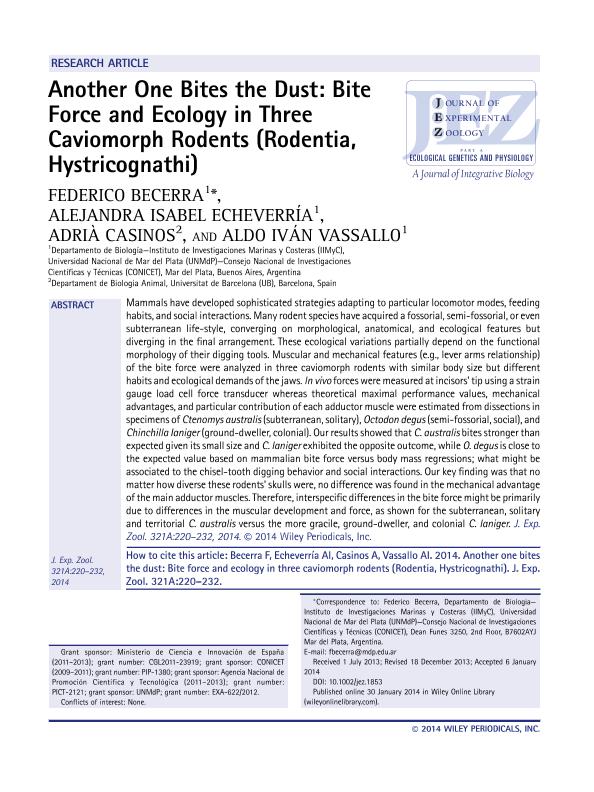Artículo
Another one bites the dust: Bite force and ecology in three caviomorph rodents (Rodentia, Hystricognathi)
Fecha de publicación:
06/2014
Editorial:
Wiley-liss, Div John Wiley & Sons Inc
Revista:
Journal of Experimental Zoology Part A: Ecological Genetics and Physiology
ISSN:
1932-5223
Idioma:
Inglés
Tipo de recurso:
Artículo publicado
Clasificación temática:
Resumen
Mammals have developed sophisticated strategies adapting to particular locomotor modes, feeding habits, and social interactions. Many rodent species have acquired a fossorial, semi-fossorial, or even subterranean life-style, converging on morphological, anatomical, and ecological features but diverging in the final arrangement. These ecological variations partially depend on the functional morphology of their digging tools. Muscular and mechanical features (e.g., lever arms relationship) of the bite force were analyzed in three caviomorph rodents with similar body size but different habits and ecological demands of the jaws. In vivo forces were measured at incisors' tip using a strain gauge load cell force transducer whereas theoretical maximal performance values, mechanical advantages, and particular contribution of each adductor muscle were estimated from dissections in specimens of Ctenomys australis (subterranean, solitary), Octodon degus (semi-fossorial, social), and Chinchilla laniger (ground-dweller, colonial). Our results showed that C. australis bites stronger than expected given its small size and C. laniger exhibited the opposite outcome, while O. degus is close to the expected value based on mammalian bite force versus body mass regressions; what might be associated to the chisel-tooth digging behavior and social interactions. Our key finding was that no matter how diverse these rodents' skulls were, no difference was found in the mechanical advantage of the main adductor muscles. Therefore, interspecific differences in the bite force might be primarily due to differences in the muscular development and force, as shown for the subterranean, solitary and territorial C. australis versus the more gracile, ground-dweller, and colonial C. laniger.
Archivos asociados
Licencia
Identificadores
Colecciones
Articulos(IIMYC)
Articulos de INSTITUTO DE INVESTIGACIONES MARINAS Y COSTERAS
Articulos de INSTITUTO DE INVESTIGACIONES MARINAS Y COSTERAS
Citación
Becerra, Federico; Echeverría, Alejandra Isabel; Casinos, Adrià; Vassallo, Aldo Iván; Another one bites the dust: Bite force and ecology in three caviomorph rodents (Rodentia, Hystricognathi); Wiley-liss, Div John Wiley & Sons Inc; Journal of Experimental Zoology Part A: Ecological Genetics and Physiology; 321; 4; 6-2014; 220-232
Compartir
Altmétricas




